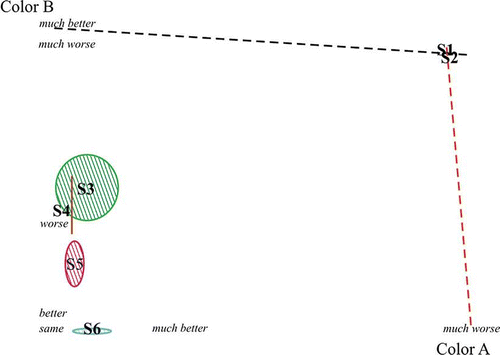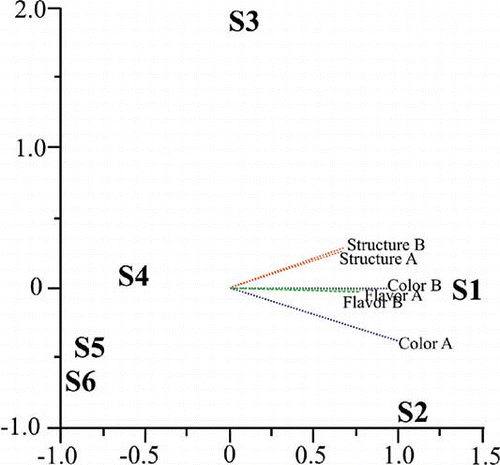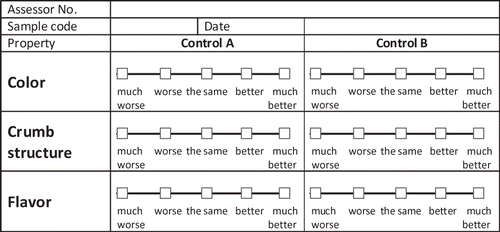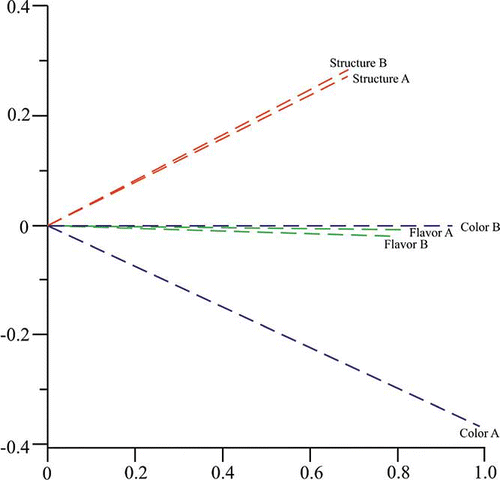Abstract
The aim of this article was to present the sensory evaluation of commercial wholemeal bread as a discriminative tool by selecting its optimum sensory properties in comparison with two control samples. Generated data were subjected to the multivariate analysis of variance and discriminative analysis. The obtained results showed that sensory evaluation could be a very useful tool for recognition of faked wholemeal bread with the exception of bread made from ready-to-bake mixtures. The color of the samples was the optimal property for the distinction of faked wholemeal bread.
INTRODUCTION
There is a growing demand for a new generation of healthier food products, which at the same time should have excellent sensory quality. Worldwide bread consumption accounts for one of the largest consumed foodstuffs. Although bread could be considered as a typical product in which basic (flour, water, salt, leavening agents) and specific ingredients (sugar and fat) as well as baking improvers are involved, new perspectives in the bakery industry appeared with the use of functional and nutritionally important ingredients, such as wholemeal flour, that have a beneficial impact on consumer health in general.[Citation1–4] Whole-grain products and products made with the addition of other cereals or flours of higher extraction rate, retain the bran and germ or part of them, which provide nutritionally important macro- (carbohydrates, dietary fiber, proteins, lipids) and micronutrients (vitamins, minerals, antioxidants, phytochemicals).[Citation5,Citation6] Therefore, these products with the intact structure of grains contribute to the beneficial effect in terms of prevention and management of diabetes, colon cancer and other bowel disorders, cardiovascular diseases, etc.[Citation7–17] Using these facts, whole-grain products are consumed more than ever before. Hence, the consumer perception of wholemeal bread is becoming extremely important. In order to satisfy the increased market demands for functional bakery products, the producers are facing a deficiency in the main raw material—wholemeal flour. Therefore, to satisfy consumer demands, bakers as well as the producers of ready-to-bake blends tend to use flour of lower extraction rates with the addition of an adequate amount of bran. Also, to meet the appearance of wholemeal bread, some producers tend to use the additives that give the bread color similar to the color of wholemeal bread (e.g., roasted malt). However, this kind of product is not characterized by the nutritional properties of wholemeal bread. Moreover, in order to simplify the production process or to produce bread with higher volume, some producers fail to add or add less bran into the blends but label the end-product as wholemeal bread only on the basis of its dark color that comes from the roasted malt. In this way, consumers are misled by consuming the product of a poorer nutritional quality without a beneficial effect to health. Determination of dietary fibers and phytic acid content could be successfully used for the objective recognition of fake wholemeal bread.[Citation18] However, the successful recognition of the genuine wholemeal bread using sensory evaluation is still an enormous problem providing that consumers' choice of the certain product is mainly based on their sensory perception. The literature has not covered this kind of topic so far. The aim of this article was to present a practical method for the sensory evaluation of commercial wholemeal bread as a discriminative tool by selecting its optimum sensory properties in comparison with two control samples.
MATERIALS AND METHODS
Sample Selection
Six commercially available breads labeled as wholemeal were chosen for the study. All breads were produced and purchased from local bakeries on the day of testing. For sensory evaluation, the samples were labeled with random numbers but in this article the results are shown by using the numbers codes (1, 2, 3, 4, 5, and 6). The bread samples 1, 2, and 3 were made from semi-white wheat flour (ash content 0.85 g/100 g dry matter), sample 4 was made from Pur-Pur® ready-to-bake mixture (Backaldrin, Asten, Austria), sample 5 was multigrain bread (wholemeal wheat, rye, wheat bran, oil seeds), and sample 6 was wholemeal wheat bread. The control bread samples (A and B) were prepared using a formulation given in . Commercially available purchased roasted malt was used as a color agent.
Table 1 Control bread formulation
Sensory Evaluation
A panel of seven assessors with experience in sensory analysis of baked products (four females, three males) aged between 28 and 42 were selected and recruited from the Institute of Food Technology, Novi Sad, Serbia. The initial training stage of assessors involved introducing the method to assessors, and training using the real products-control samples. Six sessions were performed lasting about 2 h each. The first three sessions were introduction to the sensory attributes of wholemeal bread (crumb color, crumb structure, flavor/aroma) during which the assessors were introduced to the definition of terms to be used. The remaining sessions corresponded to the evaluation of control samples used in the further study. Assessors were asked to evaluate the degree of similarity between each sample and the two control samples regarding crumb color, crumb structure, and flavor using a 5-point scale suggested by Pestorić et al.[Citation19] The center of the scale corresponded to the case when the intensity of the sample property was the same as the property of the control samples (). The left side of the scale corresponded to lower assessments (“worse” and “much worse”), while the right side corresponded to better assessments (“better” and “much better”) of each property (). All samples were assessed in five replicates (7 * 5 observations per sample). For evaluation, approximately 50 g of each sample, including the crust and crumb, was presented to assessors on 3-digit coded trays. Plain water was used for mouth rinsing before and after each sample testing.
Table 2 Description of properties of control samples
In this article, the assessments of properties are shown by using the following codes: Color A—color of the sample in comparison with the control sample A; Color B—color of the sample in comparison with the control sample B; Structure A—crumb structure of the sample in comparison with the control sample A; Structure B—crumb structure of the sample in comparison with the control sample B; Flavor A—flavor of the sample in comparison with the control sample A; and Flavor B—flavor of the sample in comparison with the control sample B.
Statistical Design
Statistical analysis comprised the evaluation of sample properties in relation to the control samples (A and B) by non-parametric methods according to the frequency of assessments. Non-parametric data were scaled by using contingency tables in order to generate the value for each assessment. Thus, it was enabled to use statistical tests for ratio scales. Generated data were subjected to the multivariate analysis of variance (MANOVA) and discriminative analysis. Univariate methods applied included Roy's test, Pearson's contingency coefficient (χ), and multiple regression coefficient (R). On the basis of discrimination coefficients, the genuine properties of samples of different bread producers were selected for further analysis. Also, the prediction of homogeneity of assessments for each sample was done. Statistical analysis of sensory evaluation of the panel was conducted using software developed by the Agency “SMARTLINE” (Novi Sad, Serbia).
RESULTS AND DISCUSSION
In order to avoid loss of information using non-parametric methods, data were scaled according to contingency tables. In this way, each category is associated with a real number according to frequency. It is a known fact that rank-ordered data can be processed by methods based on ranking scales, which can provide new assumptions not possible by applying methods and tests based on non-parametric scales. Data ranking does not exclude the application of non-parametric tests. Hence, it is possible to use MANOVA, discriminative analysis, and other parametric methods on rank-ordered data. Within univariate tests, several can be used: Roy's test, Pearson's coefficient of contingency, or coefficient of multiple correlations. In this manner, new assumptions are obtained that provide a new dimension to the investigation. Discrimination coefficient is a measure of ability to distinguish between properties that determine subunit specifics and irrelevant properties by which exclusion of the observed space could be reduced. Also, the estimation of subunit homogeneity gives additional information about the observed phenomenon. The main purpose of the mathematic-statistic analysis is to determine properties of each subunit, homogeneity, and distance between them in relation to selected properties in order to achieve reliable and precise assumptions and estimation with certain confidence.[Citation20]
The applied MANOVA test (P ≤ 0.05) and discriminant analysis (P ≤ 0.05) pointed out that there were significant differences between the samples originated from different producers in relation to the control samples (A and B). Also, the existence of clearly defined boundaries between the sensory properties of certain samples was reported. The p-value of χ2 test and the confidence intervals of χ without zero point, indicated a strong relationship between the samples and selected sensory properties (). The samples differentiated the most in relation to the color of control samples with discrimination coefficients of 15.165 (for control sample A) and 6.392 (for control sample B), while the distinction between the samples in relation to the structure and aroma was achieved only to a certain extent (). Due to the existence of clearly defined boundaries between the sensory properties of certain samples, it was possible to determine properties of each sample ().
Table 3 Relationship and signification of differences between the samples and selected sensory properties
Table 4 Discrimination coefficients and sample properties in respect of individual assessments
The homogeneity of the sensory assessments of samples 1, 5, and 6 was 100.0% indicating that the assessors were able to recognize their properties that resulted in the same assessments. Moreover, the homogeneity of the sensory assessments of sensory properties of samples 2 and 4 was 96.0% indicating that the assessors were able to recognize the properties of the sample to a high extent, whereas 1 assessment out of 25 was assessed differently. Finally, sample 3 was evaluated by 5 different assessments out of 25 that resulted in the homogeneity of 80.0%.
The graphical view of color properties of the samples is presented in two-dimensional space by confidence interval ellipses () where the color A is shown on the horizontal axis and color B on the vertical axis with five 5-point scales. In , ellipses represent the frequencies of modalities (in our case-sample scores). The longer and wider the ellipse is, the more modalities it contains. Scale on the axes represents the modalities, which are not evenly distributed along the scale. In the case of two or more groups, the center of the ellipse that is the closest to the highest scaled value on the axe is connected with a line to the axe maximum. A line also connects the closest ellipse center to the axe minimum. This shows that the subunit represented with the ellipse has higher frequencies of modalities (scores) than the other samples. If the subsample is represented only with a line, instead of an ellipse, it means that only one score per one property exists. In the case where a point is shown instead of an ellipse, both properties are evaluated by one score. The overlapping of two or more ellipses indicates that there is no difference between the samples or if they are completely separated, there is a significant difference between the samples.[Citation20]
Figure 2 Ellipses of the frequencies of modalities for the color evaluation of the samples in relation to the color of the control samples A and B. S1: Sample 1; S2: Sample 2; S3: Sample 3; S4: Sample 4; S5: Sample 5; S6: Sample 6. (Color figure available online.)

The assessments are not evenly distributed along the scale, so the distance between the points is not uniform with a high possibility for overlapping. Also, it is a very useful tool to show the sample properties and relation between them regarding the most discriminative properties (color A and color B). The shape of confidence interval ellipses for the color evaluation of samples 3, 5, and 6 indicates the higher variability of assessments throughout the panel. Samples 1 and 2 in two-dimensional space are presented by the points indicating that they were evaluated by one single assessment (much worse in comparison to the control sample A and B) (, ). To structure the obtained data, multidimensional scaling was applied and the graph (star diagram) for exploring similarities or dissimilarities between the samples in relation to the assessment of properties was obtained ( and ). Positions of the groups in two-dimensional space imply to the distance between them calculated according to the observed data. Star diagram displays similarities between classes or levels. Each group in the star diagram is represented by a line with variable length. If the lengths of lines are obviously different, there is significant difference between the groups regarding the observed parameter, according to the frequencies of classes or levels. Also, it enables the visualization of the samples location in two-dimensional space to each evaluated property. Six sensory properties explained the first dimension, while no particular properties explained the second dimension. Since it was noticed that crumb structure and flavor were similarly evaluated with the small coefficients of determination and contribution to the differences (), they could be excluded from further consideration, and it was justified to choose the color in relation to the control sample A or B (). Since the discrimination coefficient obtained by sensory scoring of color in comparison to the control sample A is the highest (), it could be suggested that sensory evaluation in the market could be performed by using only one control sample. The position of the samples in the plot () indicates that samples 1 and 2 were characterized to the maximum extent by the color B and color A, respectively, that are opposite to samples 4, 5, and 6. The frequency of the assessments of the sample color in respect to the color of control sample A is shown in .
Figure 4 Two-dimensional view of the samples and properties. S1: Sample 1; S2: Sample 2; S3: Sample 3; S4: Sample 4; S5: Sample 5; S6: Sample 6. (Color figure available online.)

Table 5 The contingency table of the samples with respect to the color A
Obtained results showed that the assessors had the most agreement on the color of sample 1, as well as on the color of sample 2, assessing them by “much worse” (96.0%). These samples were described by pale color without visible bran particles, which indicated that samples 1 and 2 did not have the properties of wholemeal bread. Concerning the assessment of sample 3, the consensus of the assessors' assessment was decreased in comparison to the previous case. The most frequent assessment was “worse” (84%), which also indicated that the properties of sample 3 did not entirely correspond to the properties of wholemeal bread imposing to the possibility that this sample was a fake wholemeal bread without peculiar color and bran particles. The variability of the assessments for sample 4, in comparison to the previous samples 1, 2, and 3 was higher and resulted with 60% of the “worse” assessment. This sample was characterized by dark brown color and the presence of crushed cereal kernels. Thus, it could not be classified as wholemeal bread, but as bread that was produced from a bread baking mixture that contained some ingredients in small quantities giving the properties that assessors could not easily perceive as the properties of wholemeal bread. Samples 5 and 6 were perceived as wholemeal breads, described by the same, better, and much better color than the control sample (). Therefore, sample 5 was characterized by pale brown color with visible bran particles, whereas sample 6 contained more visible bran particles than sample 5. Similar results were obtained for the evaluation of the samples in respect to the control sample B (), with the exception of sample 5, which was perceived as fake wholemeal bread. The frequency of the assessments of sample 4, in this case, more clearly indicated that this sample was not the genuine wholemeal bread. However, in the case of sample 5, the visible bran particles might have been covered up by the presence of the coloring agent.
Table 6 The contingency table of the samples with respect to the color B
CONCLUSIONS
On the basis of the obtained results, it can be concluded that sensory evaluation could be a very useful tool for the recognition of fake wholemeal bread with the exception of the case when it is made from ready-to-bake mixtures. Furthermore, the results provided that the color of the samples in the assessor's perception was the most dominant sensory property that could be used for distinction of fake wholemeal bread and facilitation of sensory product control in the future product. The evaluation of the untrained panel was clearer in terms of the control sample made from pure wholemeal flour (control sample A), so in order to avoid sensory fatigue and misleading conclusions it is advisable to use simpler experiment design with only one control sample.
ACKNOWLEDGMENT
This work was financed by the Ministry of Science and Technological Development, Republic of Serbia (Project No. 20068).
REFERENCES
- Pederson , B. , Knudsen , K.E.B. and Eggum , B.O. 1989 . Nutritive value of cereal products with emphasis on the effect of milling . World Review of Nutrition and Dietetics , 60 : 1 – 5 .
- Berghöfer , E. 2000 . Bread as functional food. Getreide . Mehl und Brot , 54 : 175 – 179 .
- Cauvain , S.P. 2004 . How much more bread research do we need . Getreide Technologie , 58 : 364 – 366 .
- Hozová , B. , Dodok , L. , Olekšáková , J. and Moravčíková , P. 2006 . Choice of cereal raw materials and suitable combinations of additives for sensory quality improvement of pastry . International Journal of Food Properties , 9 : 897 – 906 .
- Plaami , S.P. 1997 . Content of dietary fibre in foods and its physiological effects . Food Reviews International , 13 : 29 – 76 .
- Mandala , I. , Polaki , A. and Yanniotis , S. 2009 . Influence of frozen storage on bread enriched with different ingredients . Journal of Food Engineering , 92 : 137 – 145 .
- Thompson , L.U. 1994 . Antioxidants and hormone-mediated health benefits of whole grains . Critical Reviews in Food Science and Nutrition , 34 : 473 – 497 .
- Auroma , O.I. 1998 . Free radicals, oxidative stress, and antioxidants in human health and disease . Journal of the American Oil Chemists' Society , 75 : 199 – 212 .
- García-Estepa , R.M. , Guerra-Hernández , E. and García-Villanova , B. 1992 . Phytic acid content in milled cereal products and breads . Food Research International , 32 : 217 – 221 .
- Miller , H.E. , Rigelhof , F. , Marquart , L. , Prakash , A. and Kanter , M. 2000 . Antioxidant content of whole grain breakfast cereals, fruits and vegetables . Journal of the American College of Nutrition , 19 : 312 – 319 .
- Truswell , A.S. 2002 . Cereal grains and coronary heart disease . European Journal of Clinical Nutrition , 56 : 1 – 14 .
- Gómez , M. , Ronda , F. , Blanco , C.A. and Caballero , P.A. 2003 . Apesteguía, A. Effect of dietary fibre on dough rheologhy and bread quality . European Food Research and Technology , 216 : 51 – 56 .
- Venn , B.J. and Mann , J.I. 2004 . Cereal grains, legumes and diabetes . European Journal of Clinical Nutrition , 58 : 1443 – 1461 .
- Liu , Q. 2007 . Whole grain phytochemicals and health . Journal of Cereal Science , 46 : 207 – 219 .
- Liyana-Pathirana , C.M. and Shahidi , F. 2007 . The antioxidant potential of milling fractions from breadwheat and durum . Journal of Cereal Science , 45 : 238 – 247 .
- Dewettinck , K. , Van Bockstaele , F. , Kühne , B. , Van De Walle , D. , Courtens , T.M. and Gellynck , X. 2008 . Nutritional value of bread: Influence of processing, food interaction and consumer perception . Journal of Cereal Science , 48 : 243 – 257 .
- Fardet , A. , Rock , E. and Rémésy , C. 2008 . Is the in vitro antioxidant potential of whole-grain cereals and cereal products well reflected in vivo? . Journal of Cereal Science , 48 : 258 – 276 .
- Filipčev , B. , Sakač , M. , Beljkaš , B. , Pestorić , M. , Šimurina , O. and Psodorov , Đ . 2009 . Nutritional quality of dark bread on the domestic market . Journal on Processing and Energy in Agriculture PTEP , 13 : 117 – 120 .
- Pestorić , M. , Pojić , M. , Mastilović , J. , Šimurina , O. , Tasić , T. , Živančev , D. and Šoronja-Simović , D. 2009 . Sensory evaluation of traditional bread in Vojvodina . Food Processing, Quality and Safety , 35 : 99 – 113 .
- Wilbur , A.T. 1984 . An Introduction to Multivariate Statistical Analysis , New York : John Wiley & Sons .

